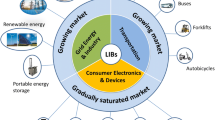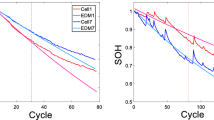Abstract
The lithium-ion battery cycle life prediction with particle filter (PF) depends on the physical or empirical model. However, in observation equation based on model, the adaptability and accuracy for individual battery under different operating conditions are not fully considered. Therefore, a novel fusion prognostic framework is proposed, in which the data-driven time series prediction model is adopted as observation equation, and combined to PF algorithm for lithium-ion battery cycle life prediction. Firstly, the nonlinear degradation feature of the lithium-ion battery capacity degradation is analyzed, and then, the nonlinear accelerated degradation factor is extracted to improve prediction ability of linear AR model. So an optimized nonlinear degradation autoregressive (ND–AR) time series model for remaining useful life (RUL) estimation of lithium-ion batteries is introduced. Then, the ND–AR model is used to realize multi-step prediction of the battery capacity degradation states. Finally, to improve the uncertainty representation ability of the standard PF algorithm, the regularized particle filter is applied to design a fusion RUL estimation framework of lithium-ion battery. Experimental results with the lithium-ion battery test data from NASA and CALCE (The Center for Advanced Life Cycle Engineering, the University of Maryland) show that the proposed fusion prognostic approach can effectively predict the battery RUL with more accurate forecasting result and uncertainty representation of probability density distribution (pdf).
















Similar content being viewed by others
References
Zhang J, Lee J (2011) A review on prognostics and health monitoring of Li-ion battery. J Power Sources 196(15):6007–6014
He W, Williard N, Osterman M, Pecht M (2011) Prognostics of lithium-ion batteries based on Dempster-Shafer theory and the Bayesian Monte Carlo method. J Power Sources 196:10314–10321
Goebel K, Saha B, Saxena A, Celaya JR, Christophersen JP (2008) Prognostics in battery health management. IEEE Instrum Meas Mag 8:33–40
Saha B, Goebel K, Poll S, Christophersen J (2009) Prognostics methods for battery health monitoring using a Bayesian framework. IEEE Trans Instrum Meas 58(2):291–297
Liu J, Wang W, Golnaraghi F (2009) A multi-step predictor with a variable input pattern for system state forecasting. Mech Syst Signal Process 23:1586–1599
Peng Y, Liu D, Peng X (2010) A review: prognostics and health management. J Electron Meas Instrum 24(1):1–8
Si XS, Wang W, Hu CH, Zhou DH (2011) Remaining useful life estimation: a review on the statistical data driven approaches. Eur J Oper Res 213(1):1–14
Luo J, Andrew B, Krishna P, Liu Q, Shunsuke C (2003) An interacting multiple model approach to model-based prognostics. In: Proceedings of IEEE international conference on system man and cybernetics. Washington, DC, pp 189–194
Pecht M, Jaai R (2010) A prognostics and health management roadmap for information and electronics-rich systems. Microelectron Reliab 50:317–323
Saha B, Goebel K, Christophersen J (2009) Comparison of prognostic algorithms for estimating remaining useful life of batteries. Trans Inst Meas Control 31:293–308
Olivares BE, Cerda Munoz MA, Orchard ME, Silva JF (2013) Particle-filtering-based prognosis framework for energy storage devices with a statistical characterization of state-of-health regeneration phenomena. IEEE Trans Instrum Meas 62:364–376
Orchard ME, Hevia-Koch P, Zhang B, Tang L (2013) Risk measures for particle-filtering-based state-of-charge prognosis in lithium-ion batteries. IEEE Trans Ind Electron 60:5260–5269
Liu D, Pang J, Zhou J, Peng Y (2013) Prognostics for state of health estimation of lithium-ion batteries based on combination Gaussian process functional regression. Microelectron Reliab 53:832–839
Liu J, Saxena A, Goebel K, Saha B, Wang W (2010) An adaptive recurrent neral network for remaining useful life prediction of lithium-ion batteries. In: Proceedings of annual conference of the prognostics and Health Management Society, Portland, Oregon, USA
Liang Y, Liang X (2006) Improving signal prediction performance of neural networks through multi-resolution learning approach. IEEE Trans Syst Man Cybern B 36:341–352
Alvin JS, Craig F, Pritpal S, Terrill A, David ER (1999) Determination of state-of-charge and state-of-health of batteries by fuzzy logic methodology. J Power Sources 80(1–2):293–300
Kozlowski JD (2003) Electrochemical cell prognostics using online impedance measurements and model-based data fusion techniques. In: IEEE aerospace conference, Big Sky, Montana
Liu J, Wang W, Ma F, Yang Y, Yang C (2012) A data-model-fusion prognostic framework for dynamic system state forecasting. Eng Appl Artif Intel 25:814–823
Saha B, Poll S, Goebel K (2007) An integrated approach to battery health monitoring using bayesian regression and state estimation. In: IEEE Autotestcon, Baltimore, MD, USA
Xing Y, Ma EWM, Tsui KL, Pecht M (2013) An ensemble model for predicting the remaining useful performance of lithium-ion batteries. Microelectron Reliab 53:811–820
Fan J, Yao Q (2003) Nonlinear time series: nonparametric and parametric methods. Springer, New York
Akaike H (1974) A new look at the statistical model identification. IEEE Trans Automat Contr 19:716–723
Simon D (2006) Optimal state estimation: Kalman, H Infinity and Nonlinear Approaches. Wiley, New Jersey
Gordon NJ, Salmond DJ, Smith AFM (1993) Novel approach to nonlinear/non-Gaussian Bayesian state estimation. In: IEEE proceedings on radar and signal processing, pp 107–113
LeGland F, Musso C, Oudjane N (1998) An analysis of regularized interacting particle methods for nonlinear filtering. In: Proceedings of the IEEE European workshop on computer intensive methods in control and data processing. Prague, Czech Republic, pp 167–174
Arulampalam MS, Maskell S, Gordon N, Clapp T (2001) A tutorial on particle filters for online nonlinear/non-Gaussian Bayesian tracking. IEEE Trans Signal Process 50:174–188
Saha B, Goebel K (2007) Battery data set, NASA Ames prognostics data repository, [http://ti.arc.nasa.gov/project/prognostic-data-repository], NASA Ames, Moffett Field, CA, USA
Saha B, Goebel K (2009) Modeling li-ion battery capacity depletion in a particle filtering framework. In: Annual conference of the prognostics and health management society, San Diego, CA, USA
Saxena A, Celaya J, Saha B, Saha S, Goebel K (2009) Evaluating algorithmic performance metrics tailored for prognostics. In: Proceedings of IEEE aerospace conference, Big Sky, MO, USA
Acknowledgments
This research work is supported partly by National Natural Science Foundation of China (61301205), Natural Scientific Research Innovation Foundation in Harbin Institute of Technology (HIT.NSRIF.2014017), Research Fund for the Doctoral Program of Higher Education of China (20112302120027), the twelfth government advanced research fund (51317040302). The author would also express his sincere thanks to Dr. Wei He at CALCE of The University of Maryland and Dr. Eden Ma at PHM Center of City University of Hong Kong for their help on the CALCE battery data set. The authors would also like to thank anonymous reviewers for their valuable comments.
Author information
Authors and Affiliations
Corresponding author
Rights and permissions
About this article
Cite this article
Liu, D., Luo, Y., Liu, J. et al. Lithium-ion battery remaining useful life estimation based on fusion nonlinear degradation AR model and RPF algorithm. Neural Comput & Applic 25, 557–572 (2014). https://doi.org/10.1007/s00521-013-1520-x
Received:
Accepted:
Published:
Issue Date:
DOI: https://doi.org/10.1007/s00521-013-1520-x




